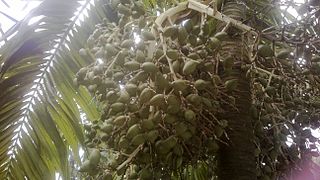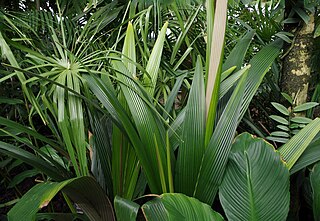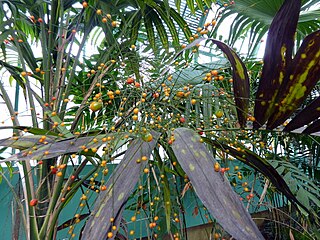
Acanthophoenix is a genus of flowering plants in the palm family from the Mascarene Islands in the Indian Ocean, where they are commonly called palmiste rouge. A genus long in flux, three species are currently recognized, though unsustainable levels of harvesting for their edible palm hearts have brought them all to near extinction in habitat. They are closely related to the Tectiphiala and Deckenia genera, differing in the shape of the staminate flower. The name combines the Greek words for "thorn" and "date palm".
Barcella is a monotypic genus of flowering plant in the palm family found in the States of Amazonas and Roraima in northwestern Brazil. The only known species is Barcella odora which is used by the Brazilian peoples in construction and for various thatched goods.

Calyptrocalyx is a monoecious genus of flowering plant in the palm family found in Papua New Guinea and the nearby Maluku Islands. Ranging from small to large, the palms in this genus are increasingly found in cultivation owing largely to their purple, red, and orange colored, new foliage. At least 26 species have been described while others, known only by local names, have not yet received a taxonomic account. Palms formerly classified within Paralinospadix have been incorporated into this genus. It is named from 2 Greek words meaning 'covered' and 'calyx'.

Actinorhytis is a monotypic genus of flowering plant in the palm family found in Oceania and southeast Asia. The lone species, Actinorhytis calapparia is a rain forest inhabitant and has very large fruit. The genus name is from two Greek words meaning 'ray' and 'fold' which describe the endosperm of the seed.
Clinosperma bractealis is a species of palm tree in the palm family

Dictyosperma is a monotypic genus of flowering plant in the palm family found in the Mascarene Islands in the Indian Ocean. The sole species, Dictyosperma album, is widely cultivated in the tropics but has been farmed to near extinction in its native habitat. It is commonly called princess palm or hurricane palm, the latter owing to its ability to withstand strong winds by easily shedding leaves. It is closely related to, and resembles, palms in the genus Archontophoenix. The genus is named from two Greek words meaning "net" and "seed" and the epithet is Latin for "white", the common color of the crownshaft at the top of the trunk.
Cyphokentia macrostachya is a species of palm endemic to New Caledonia.

Laccospadix is a monotypic genus of flowering plant in the palm endemic to Queensland. Only one species is known, Laccospadix australasicus, commonly called Atherton palm or Queensland kentia. The two Greek words from which it is named translate to "reservoir" and "spadix".

Lepidorrhachis is a monotypic genus of flowering plant in the palm family restricted to Lord Howe Island. The genus name for the single, monoecious species, Lepidorrhachis mooreana, comes from two Greek word meaning "scale" and "rachis", and the epithet honors Charles Moore, first director of the Sydney Botanical Gardens. The common name is Little Mountain Palm.

Ceratolobus is a dioecious genus of flowering plant in the palm family found in Southeast Asia, commonly called rotan. They are only differentiated from close relatives like Korthalsia, Calamus, and Daemonorops by leaf sheath appendages or inflorescence variations. The Greek genus name combines "horn" and "capsule".

Oraniopsis is a monotypic genus of flowering plant in the palm family from Queensland, Australia, where the only known species, Oraniopsis appendiculata, grows in mountainous rain forest. Dioecious and extremely slow growing, the name means "similar to Orania" and the Latin epithet translates to "appendaged".
Plectocomiopsis is a dioecious genus of flowering plant in the palm family found in Indochina, Malaysia, Borneo and Sumatra. Hapaxanthic and armed with spines, they are a climbing rattan, closely related to the Myrialepis palms. The name is Greek for "similar to Plectocomia", another close relative.
Pogonotium is a dioecious genus of flowering plant in the palm family found in Malaysia and Borneo. Its close relatives are climbing rattans and while partially armed with climbing apparatus, its habit is sprawling and leaning but not effective climbing. The reduced inflorescence nestled between the auricles is unusual and distinguishes it from similar relatives like Calamus, Daemonorops and Ceratolobus. The name is Greek meaning "bearded".

Allagoptera caudescens is a species of flowering plant in the palm family endemic to Brazil, where it is known as buri palm. The name combines the Greek words for "many" and "anther" with the name of another palm genus Cocos, and the epithet is Latin for "bearlike", referring to the hairy tomentum. It was formerly classified as Polyandrococos caudescens, the only species in the genus Polyandrococos.

Ptychococcus is a monoecious genus of flowering plant in the palm family from New Guinea and the Solomon Islands. They are closely related to Ptychosperma, only differentiated by the seed shape and endocarp type. The name is a combination of the Greek for "fold" and the Latin for "berry".
Retispatha is a rare, monotypic genus of flowering plant in the palm family endemic to Borneo, where the sole species, Retispatha dumetosa, is known as wi tebu bruang or "the bear's sugar cane". The name combines Latin and Greek words meaning "network" and "spathe", and the species epithet means "bushy". While classified with other rattans, they retain only superficial climbing organs; they sprawl and lean but are not true climbers.

Sommieria is a monotypic genus of flowering plant in the palm family endemic to New Guinea where they grow in rain forest understory. The sole species is Sommieria leucophylla. They resemble the Asterogyne palms but are most closely related to those members of Heterospathe with short stems and sparsely branched inlforescences. The name honors Stephen Sommier, European botanist.

Synechanthus is a monoecious genus of flowering plant in the palm family found in Mexico, Central and South America. Commonly called bola, palmilla, or jelly bean palm, they are closely related to members of Chamaedorea, only distinguished by their flower and fruit form. The Greek genus name is a combination of "united" and "flower".

Cyphophoenix alba is a species of palm in the family Arecaceae endemic to New Caledonia. It was previously placed in the genus Veillonia.

The Ceroxyloideae are a subfamily of flowering plants in the palm family found mainly in the Americas with an outlying genus in each of Australia, Madagascar, and the Comoros. Recently revised, the former subfamily Phytelephantoideae was reduced to the tribal level and included, while the Hyophorbeae tribe was reassigned to Arecoideae; it now contains eight genera.













